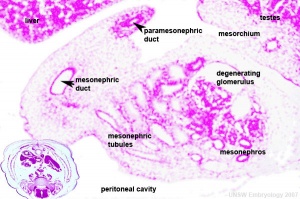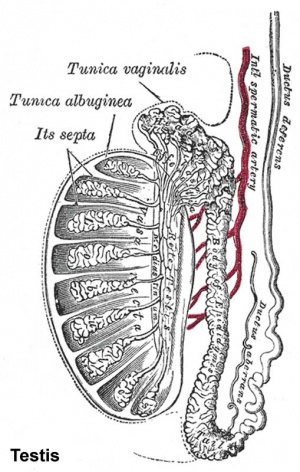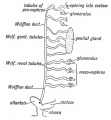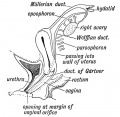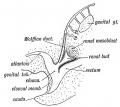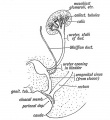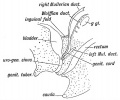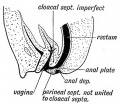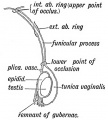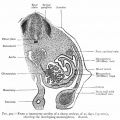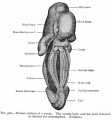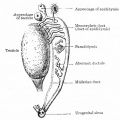Genital System Development: Difference between revisions
mNo edit summary |
mNo edit summary |
||
| Line 298: | Line 298: | ||
<gallery> | <gallery> | ||
File:Keith1902 fig079.jpg|Fig. 79. Scheme of the Wolffian Body of the right side. | File:Keith1902 fig079.jpg|Fig. 79. Scheme of the Wolffian Body of the right side. | ||
File:Keith1902 fig080.jpg|Fig. 80. | File:Keith1902 fig080.jpg|Fig. 80. Position of the Wolffian and Genital Ridges on the dorsal wall of the abdomen. | ||
File:Keith1902 fig081.jpg|Fig. 81. Remnants of the Wolffian Body in the Female. | File:Keith1902 fig081.jpg|Fig. 81. Remnants of the Wolffian Body in the Female. | ||
File:Keith1902 fig082.jpg|Fig. 82. Remnant of the "Wolffian Body in the Male. | File:Keith1902 fig082.jpg|Fig. 82. Remnant of the "Wolffian Body in the Male. | ||
File:Keith1902 fig083.jpg|Fig. 83. The Origin of the Renal Bud (diagrammatic). | File:Keith1902 fig083.jpg|Fig. 83. The Origin of the Renal Bud (diagrammatic). | ||
File:Keith1902 fig084.jpg|Fig. 84. The Termination of the Ureter in the Bladder and Sub-division of the Renal Bud | File:Keith1902 fig084.jpg|Fig. 84. The Termination of the Ureter in the Bladder and Sub-division of the Renal Bud | ||
File:Keith1902 fig085.jpg|Fig. 85. A transverse section to show | File:Keith1902 fig085.jpg|Fig. 85. A transverse section to show Wolffian and Müllerian Ducts arise, and their position in the Wolffian Ridge. | ||
File:Keith1902 fig086.jpg|Fig. 86. Diagram of the Genital Ducts at -the commencement of the 3rd month of foetal life. Lateral view. | File:Keith1902 fig086.jpg|Fig. 86. Diagram of the Genital Ducts at -the commencement of the 3rd month of foetal life. Lateral view. | ||
File:Keith1902 fig087.jpg|Fig. 87. Diagram of the Müllerian Ducts at the commencement of the 3rd month. Ventral view. | File:Keith1902 fig087.jpg|Fig. 87. Diagram of the Müllerian Ducts at the commencement of the 3rd month. Ventral view. | ||
File:Keith1902 fig088.jpg|Fig. 88. Evolution of the Human Form of Uterua | File:Keith1902 fig088.jpg|Fig. 88. Evolution of the Human Form of Uterua. | ||
File:Keith1902 fig089.jpg|Fig. 89. Showing the manner in which the Mulleriau Ducts fuse to form the Uterus and Vagina. | File:Keith1902 fig089.jpg|Fig. 89. Showing the manner in which the Mulleriau Ducts fuse to form the Uterus and Vagina. | ||
File:Keith1902 fig090.jpg|Fig. 90. A section of the Prostate showing the Hemnants of the lower ends of the Mttllerian Ducts in the male. | File:Keith1902 fig090.jpg|Fig. 90. A section of the Prostate showing the Hemnants of the lower ends of the Mttllerian Ducts in the male. | ||
File:Keith1902 fig091.jpg|Fig. 91. A section of a Prostate showing an unusually developed Uterus Masculinus. (After Primrose.) | File:Keith1902 fig091.jpg|Fig. 91. A section of a Prostate showing an unusually developed Uterus Masculinus. (After Primrose.) | ||
File:Keith1902 fig092.jpg|Fig. 92. Section showing the Uro-genital Sinus. A. | File:Keith1902 fig092.jpg|Fig. 92. Section showing the Uro-genital Sinus. A. 4th month female human foetus. B. 5th month female human foetus. | ||
File:Keith1902 fig093.jpg|Fig. 93. Section showing the Uro-genital Sinus in the male foetus. | File:Keith1902 fig093.jpg|Fig. 93. Section showing the Uro-genital Sinus in the male foetus. | ||
File:Keith1902 fig094.jpg|Fig. 94. A section to show the condition of the Vagina and Uterus at the 7th month of foetal life. | File:Keith1902 fig094.jpg|Fig. 94. A section to show the condition of the Vagina and Uterus at the 7th month of foetal life. | ||
File:Keith1902 fig095.jpg|Fig. 95. The Division of the Cloaca into Rectal and Uro-genital Parts. | File:Keith1902 fig095.jpg|Fig. 95. The Division of the Cloaca into Rectal and Uro-genital Parts. | ||
File:Keith1902 fig096.jpg|Fig. 96. | File:Keith1902 fig096.jpg|Fig. 96. Imperforate Anus due to a persistence of the Anal Plate. | ||
File:Keith1902 fig097.jpg|Fig. 97. | File:Keith1902 fig097.jpg|Fig. 97. Rectal part of the Anal Plate has persisted and the Cloacal Septum has failed to fuse with the Perineal Septum. | ||
File:Keith1902 fig098.jpg|Fig. 98. The Uro-genital Cleft or Depression and the Genital Tubercle and Folds towards the end of the 2nd month. | File:Keith1902 fig098.jpg|Fig. 98. The Uro-genital Cleft or Depression and the Genital Tubercle and Folds towards the end of the 2nd month. | ||
File:Keith1902 fig099.jpg|Fig. 99. A section of the male bladder and urethra at birth | File:Keith1902 fig099.jpg|Fig. 99. A section of the male bladder and urethra at birth. | ||
File:Keith1902 fig100.jpg|Fig. 100. A A section to show the condition of parts in Ectopia Vesicae. | File:Keith1902 fig100.jpg|Fig. 100. A A section to show the condition of parts in Ectopia Vesicae. | ||
File:Keith1902 fig101.jpg|Fig. 101. A diagram to show the position at which the Prostatic Tubules arise. | File:Keith1902 fig101.jpg|Fig. 101. A diagram to show the position at which the Prostatic Tubules arise. | ||
File:Keith1902 fig102.jpg|Fig. 102. The Position of the Testis in a foetus of 2£ months . | File:Keith1902 fig102.jpg|Fig. 102. The Position of the Testis in a foetus of 2£ months . | ||
File:Keith1902 fig103.jpg|Fig. 103. Showing the Position of the Testis at the 6th month, and the Formation of the Gubernaculum Testis. | File:Keith1902 fig103.jpg|Fig. 103. Showing the Position of the Testis at the 6th month, and the Formation of the Gubernaculum Testis. | ||
File:Keith1902 fig104.jpg|Fig. 104. | File:Keith1902 fig104.jpg|Fig. 104. Structures in the wall of the abdomen are carried out so as to form the Inguinal Canal and Coverings of the Testis. | ||
File:Keith1902 fig105.jpg|Fig. 105. A diagram of the Processus Vaginalis. | File:Keith1902 fig105.jpg|Fig. 105. A diagram of the Processus Vaginalis. | ||
</gallery> | </gallery> | ||
:[[Book - Human Embryology and Morphology 9|'''The Uro-genital System''']]: [[:File:Keith1902 fig079.jpg|Fig. 79. Wolffian Body]] | [[:File:Keith1902 fig080.jpg|Fig. 80. Wolffian and Genital Ridges]] | [[:File:Keith1902 fig081.jpg|Fig. 81. Female Wolffian Body Remnants]] | [[:File:Keith1902 fig082.jpg|Fig. 82. Male Wolffian Body Remnants]] |[[:File:Keith1902 fig083.jpg|Fig. 83. Renal Bud]] | [[:File:Keith1902 fig084.jpg|Fig. 84. Ureter in the Bladder]] | [[:File:Keith1902 fig085.jpg|Fig. 85. Wolffian and Müllerian Ducts]] | [[:File:Keith1902 fig086.jpg|Fig. 86. Genital Ducts 3rd month]] | [[:File:Keith1902 fig087.jpg|Fig. 87. Müllerian Ducts 3rd month]] | [[:File:Keith1902 fig088.jpg|Fig. 88. Uterus]] | [[:File:Keith1902 fig089.jpg|Fig. 89. Uterus and Vagina]] | [[:File:Keith1902 fig090.jpg|Fig. 90. Prostate remnants of Müllerian Ducts]] | [[:File:Keith1902 fig091.jpg|Fig. 91. Prostate showing an unusual Uterus Masculinus]] | [[:File:Keith1902 fig092.jpg|Fig. 92. Female Uro-genital Sinus]] | [[:File:Keith1902 fig093.jpg|Fig. 93. Male Uro-genital Sinus]] | [[:File:Keith1902 fig094.jpg|Fig. 94. Vagina and Uterus at 7th month]] | [[:File:Keith1902 fig095.jpg|Fig. 95. Division of the Cloaca]] | [[:File:Keith1902 fig096.jpg|Fig. 96. Imperforate Anus]] | [[:File:Keith1902 fig097.jpg|Fig. 97. Cloacal Septum has failed to fuse with Perineal Septum]] | [[:File:Keith1902 fig098.jpg|Fig. 98. The Uro-genital Cleft 2nd month]] | [[:File:Keith1902 fig099.jpg|Fig. 99. Male bladder and urethra at birth]] | [[:File:Keith1902 fig100.jpg|Fig. 100. Ectopia Vesicae]] | [[:File:Keith1902 fig101.jpg|Fig. 101. Prostatic Tubules]] | [[:File:Keith1902 fig102.jpg|Fig. 102. Testis in a foetus of 2£ months]] | [[:File:Keith1902 fig103.jpg|Fig. 103. Testis at the 6th month]] | [[:File:Keith1902 fig104.jpg|Fig. 104. Inguinal Canal and Coverings of the Testis]] | [[:File:Keith1902 fig105.jpg|Fig. 105. Processus Vaginalis]] | [[Book_-_Human_Embryology_and_Morphology_Figures|Figures]] | |||
<gallery> | <gallery> | ||
Revision as of 18:30, 1 June 2014
| Embryology - 26 Apr 2024 |
|---|
| Google Translate - select your language from the list shown below (this will open a new external page) |
|
العربية | català | 中文 | 中國傳統的 | français | Deutsche | עִברִית | हिंदी | bahasa Indonesia | italiano | 日本語 | 한국어 | မြန်မာ | Pilipino | Polskie | português | ਪੰਜਾਬੀ ਦੇ | Română | русский | Español | Swahili | Svensk | ไทย | Türkçe | اردو | ייִדיש | Tiếng Việt These external translations are automated and may not be accurate. (More? About Translations) |
Introduction
The male and female reproductive systems develop initially "indifferently", it is the product of the Y chromosome SRY gene that makes the "difference". Mesonephric duct (Wolffian Duct) and paramesonephric (Müllerian Duct) contribute the majority of male and female internal genital tract respectively.
The mesonephric/paramesonephric duct changes are one of the first male/female differences that occur in development, while external genitaila remain indeterminate in appearance for quite a while.
There are many different issues to consider in the development of the genital system. Importantly its sex chromosome dependence, late embryonic/fetal differential development, complex morphogenic changes, long time-course, hormonal sensitivity and hormonal influences make it a system prone to many different abnormalities.
This current page provides only a general introduction to the topic, use the links listed below to read about specific developmental topics.
Some Recent Findings
|
| More recent papers |
|---|
|
This table allows an automated computer search of the external PubMed database using the listed "Search term" text link.
More? References | Discussion Page | Journal Searches | 2019 References | 2020 References Search term: Genital Embryology <pubmed limit=5>Genital Embryology</pubmed> |
Textbooks
- Human Embryology (2nd ed.) Larson Chapter 10 p261-306
- The Developing Human: Clinically Oriented Embryology (6th ed.) Moore and Persaud Chapter 13 p303-346
- Before We Are Born (5th ed.) Moore and Persaud Chapter 14 p289-326
- Essentials of Human Embryology, Larson Chapter 10 p173-205
- Human Embryology, Fitzgerald and Fitzgerald Chapter 21-22 p134-152
- Developmental Biology (6th ed.) Gilbert Chapter 14 Intermediate Mesoderm
| UNSW Students | |
|---|---|

|
You have access the following online Embryology textbooks through the UNSW Library. |

|
Moore, K.L. & Persuad, T.V.N. (2008). The Developing Human: clinically oriented embryology (8th ed.). Philadelphia: Saunders. |

|
Schoenwolf, G.C., Bleyl, S.B., Brauer, P.R. and Francis-West, P.H. (2009). Larsen’s Human Embryology (4th ed.). New York; Edinburgh: Churchill Livingstone. |
Objectives
- Understand the role of the Y chromosome in sex determination.
- Understand the differences in male/female duct develpoment (mesonephric/paramesonephric).
- Compare the development of the cloaca in the male and female.
- Understand the developmental abnormalities in male and female development.
Movies
| Genital Movies | |||||||||||||||||||
|---|---|---|---|---|---|---|---|---|---|---|---|---|---|---|---|---|---|---|---|
|
|
|
|
| |||||||||||||||
|
|
| |||||||||||||||||
| Mouse Primordial Germ Cell Migration | |||||||||||
|---|---|---|---|---|---|---|---|---|---|---|---|
|
|
| |||||||||
| Mouse Primordial Germ Cell Migration | |||||||||||
|---|---|---|---|---|---|---|---|---|---|---|---|
|
|
| |||||||||
Development Overview
Three main stages during development, mesonephric/paramesonephric duct changes are one of the first male/female differences that occur in development, while external genitaila remain indeterminate in appearance for quite a while.
- Differentiation of gonad (Sex determination)
- Differentiation of internal genital organs
- Differentiation of external genital organs
The 2nd and 3rd stages dependent on endocrine gonad. Reproductive development has a long maturation timecourse, begining in the embryo and finishing in puberty. (More? Puberty Development)
Sexual Development Genes
Table below modified from Table 1. Genes implicated in sexual development in mammals in recent review article.[5]
| Gene | Protein Function | Gonad Phenotype of Null Mice | Human Syndrome | |
| Bipotential gonad | ||||
| Wt1 | Transcription factor | Blockage in genital ridge development | Denys-Drash, WAGR, Frasier syndrome | |
| Sf1 | Nuclear receptor | Blockage in genital ridge development | Embryonic testicular regression syndrome | |
| Lhx9 | Transcription factor | Blockage in genital ridge development | a | |
| Emx2 | Transcription factor | Blockage in genital ridge development | a | |
| M33 | Transcription factor | Gonadal dysgenesis | a | |
| Testis-determining pathway | ||||
| Gata4/Fog2 | Transcription/cofactor | Reduced Sry levels, XY sex reversal | a | |
| Sry | Transcription factor | XY sex reversal | XY sex reversal (LOF); XX sex reversal (GOF) | |
| Sox9 | Transcription factor | XY sex reversal | Campomelic dysplasia, XX sex reversal (GOF) | |
| Sox8 | Transcription factor | XY sex reversal in combination with partial loss of Sox9 function | a | |
| Fgf9 | Signaling molecule | XY sex reversal | a | |
| Dax1 | Nuclear receptor | Impaired testis cord formation and spermatogenesis | Hypogonadism | |
| Pod1 | Transcription factor | XY sex reversal | a | |
| Dhh | Signaling molecule | Impaired differentiation of Leydig and PM cells | XY gonadal dysgenesis | |
| Pgdra | Receptor | Reduction in mesonephric cell migration | a | |
| Pgds | Enzyme | No phenotype | a | |
| Arx | Transcription factor | Abnormal testicular differentiation | X-linked lissencephaly with abnormal genitalia | |
| Atrx | Helicase | ND | ATRX syndrome | |
| Insl3 | Signaling factor | Blockage of testicular descent | Cryptorchidism | |
| Lgr8 | Receptor | Blockage of testicular descent | Cryptorchidism | |
| Hoxa10 | Transcription factor | Blockage of testicular descent | Cryptorchidism | |
| Hoxal1 | Transcription factor | Blockage of testicular descent | Cryptorchidism | |
| Amh | Hormone | No Müllerian duct degeneration | Persistent Müllerian duct syndrome | |
| Misrl1 | Receptor | No Müllerian duct degeneration | Persistent Müllerian duct syndrome | |
| Pax2 | Transcription factor | Dysgenesis of mesonephric tubules | a | |
| Lim1 | Transcription factor | Agenesis of Wolffian and Müllerian ducts | a | |
| Dmrt1 | Transcription factor | Loss of Sertoli and germ cells | XY femaleb | |
| Ovary-determining pathway | ||||
| Wnt4 | Signaling molecule | Müllerian duct agenesis, testosterone synthesis, and coelomic vessel formation | XY female (GOF) | |
| FoxL2 | Transcription factor | Premature ovarian failure | BPES | |
| Dax1 | Nuclear receptor | XY sex reversal (GOF) | XY sex reversal (GOF) | |
|
a No mutations in human sexual disorders identified to date. b Candidate gene for 9p deletion, XY sex reversal. |
Historic
See also section Historic Embryology Images.
Historic Images of Genital Changes
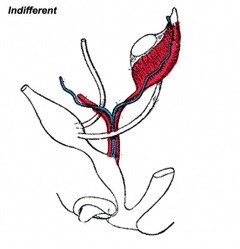
|
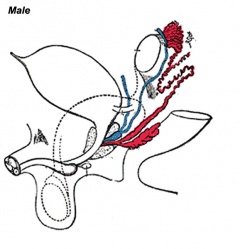
|
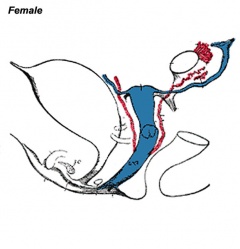
|
| Urogenital indifferent | Urogenital male | Urogenital female |
Additional Images
Historic Embryology Images
| Historic Disclaimer - information about historic embryology pages |
|---|
| Pages where the terms "Historic" (textbooks, papers, people, recommendations) appear on this site, and sections within pages where this disclaimer appears, indicate that the content and scientific understanding are specific to the time of publication. This means that while some scientific descriptions are still accurate, the terminology and interpretation of the developmental mechanisms reflect the understanding at the time of original publication and those of the preceding periods, these terms, interpretations and recommendations may not reflect our current scientific understanding. (More? Embryology History | Historic Embryology Papers) |
Keith, A. (1902) Human Embryology and Morphology. London: Edward Arnold.
Chapter 9 - The Uro-genital System
- The Uro-genital System: Fig. 79. Wolffian Body | Fig. 80. Wolffian and Genital Ridges | Fig. 81. Female Wolffian Body Remnants | Fig. 82. Male Wolffian Body Remnants |Fig. 83. Renal Bud | Fig. 84. Ureter in the Bladder | Fig. 85. Wolffian and Müllerian Ducts | Fig. 86. Genital Ducts 3rd month | Fig. 87. Müllerian Ducts 3rd month | Fig. 88. Uterus | Fig. 89. Uterus and Vagina | Fig. 90. Prostate remnants of Müllerian Ducts | Fig. 91. Prostate showing an unusual Uterus Masculinus | Fig. 92. Female Uro-genital Sinus | Fig. 93. Male Uro-genital Sinus | Fig. 94. Vagina and Uterus at 7th month | Fig. 95. Division of the Cloaca | Fig. 96. Imperforate Anus | Fig. 97. Cloacal Septum has failed to fuse with Perineal Septum | Fig. 98. The Uro-genital Cleft 2nd month | Fig. 99. Male bladder and urethra at birth | Fig. 100. Ectopia Vesicae | Fig. 101. Prostatic Tubules | Fig. 102. Testis in a foetus of 2£ months | Fig. 103. Testis at the 6th month | Fig. 104. Inguinal Canal and Coverings of the Testis | Fig. 105. Processus Vaginalis | Figures
References
Reviews
Articles
Search PubMed
Search April 2010
- Genital System Development - All (868) Review (212) Free Full Text (170)
- Genital Development - All (5365) Review (1170) Free Full Text (1024)
Search Pubmed: Genital System Development | Genital Development
Terms
| System Links: Introduction | Cardiovascular | Coelomic Cavity | Endocrine | Gastrointestinal Tract | Genital | Head | Immune | Integumentary | Musculoskeletal | Neural | Neural Crest | Placenta | Renal | Respiratory | Sensory | Birth |
Glossary Links
- Glossary: A | B | C | D | E | F | G | H | I | J | K | L | M | N | O | P | Q | R | S | T | U | V | W | X | Y | Z | Numbers | Symbols | Term Link
Cite this page: Hill, M.A. (2024, April 26) Embryology Genital System Development. Retrieved from https://embryology.med.unsw.edu.au/embryology/index.php/Genital_System_Development
- © Dr Mark Hill 2024, UNSW Embryology ISBN: 978 0 7334 2609 4 - UNSW CRICOS Provider Code No. 00098G

